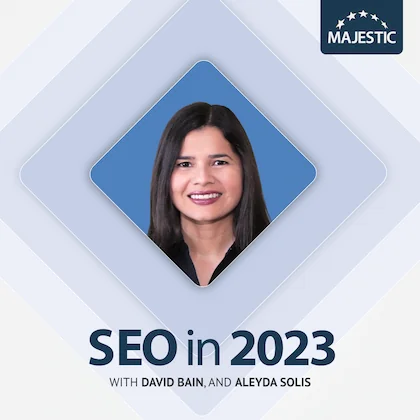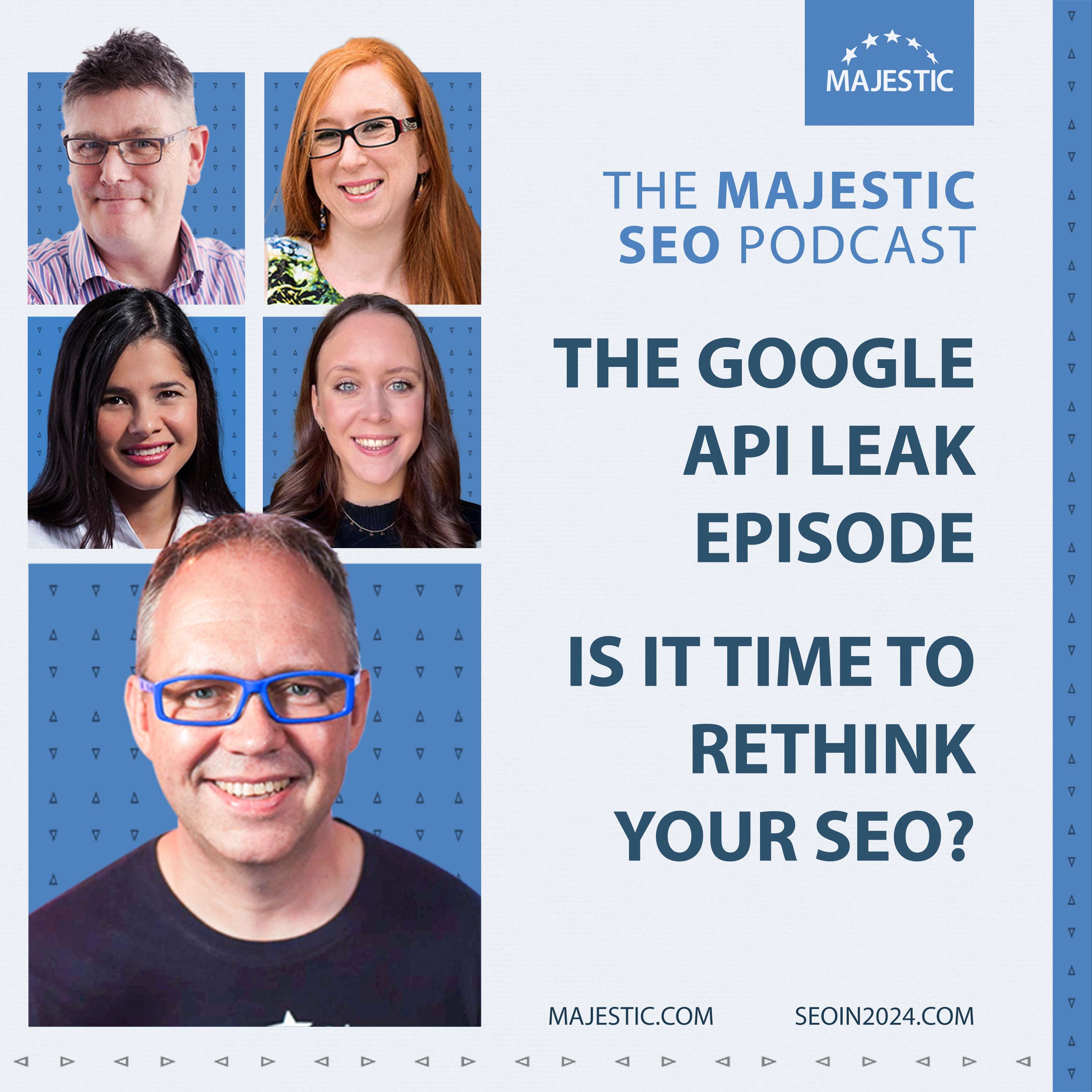-
Site Explorer
- Majestic
- Summary
- Ref Domains
- Backlinks
 New
New Lost
Lost- Context
- Anchor Text
- Pages
- Topics
- Link Graph
- Related Sites
- Advanced Tools
- Author ExplorerBeta
- Summary
- Similar Profiles
- Profile Backlinks
- Attributions
- Compare
-
Link Tools
- My Majestic
- Recent Activity
- Reports
- Campaigns
- Verified Domains
- OpenApps
- API Keys
- Keywords
- Keyword Generator
- Keyword Checker
- Search Explorer
- Link Tools
- Bulk Backlinks
- Neighbourhood Checker
- Submit URLs
- Experimental
- Index Merger
- Link Profile Fight
- Mutual Links
- Solo Links
- PDF Report
- Typo Domain
- Free SEO Tools
- Support
Set an SEO quality assurance framework
Aleyda Solis
Aleyda Solis gives SEOs in 2023 tips for creating a quality assurance framework that will prevent you from becoming part of your own SEO horror stories - including education, validation, and monitoring.

Set an SEO quality assurance framework
Aleyda says: “Learn and set an SEO quality assurance framework to avoid SEO f**k-ups, and it still might not be enough. Unfortunately, we have way too many errors in our SEO processes. Over the last year, I have seen very important SEO processes using well-established methods that are being held back by errors.
It’s something that obviously hurts our efforts, because of the way that these challenges have been tackled. It still hasn’t been properly fixed. Every single year, we see SEO horror stories, and we definitely need to make them stop.”
How do you put together an SEO quality assurance framework, and what does that look like?
“There are three key areas that I want to talk about: education, validation, and monitoring.
The main problem is that, whenever we think about an SEO quality framework and avoiding errors and mistakes, we focus on catching things quickly and combatting the damage that has already occurred. If we are only looking to catch errors after they have happened, we are already behind. It is very important that we establish actions within the framework to educate and prevent SEO mistakes in the first place. Many of these mistakes, issues, errors, and bugs happen because of misunderstandings about what we want to achieve.
We also need to set a good validation workflow to avoid launching SEO errors too. Of course, if they do end up happening, we can then minimise the issues by implementing the actions we have set in place. We need to set really good monitoring systems to catch SEO incidents for us in a way that actually makes sense.
We get alerts all the time from lots of tools, and there are often so many people involved that we end up overlooking many of these alerts. It’s important that your alerts are configured in a way that makes sense, and they are effectively captured by the people who are handling different parts of the process.”
What do people need to be educated on? Are you talking about education for SEO teams or other departments within an organisation?
“For anybody involved in different ways. Firstly, you need to be educating stakeholders, and even decision-makers. Many of the errors that we end up seeing are a result of the boss or the director suddenly asking for something to be changed. These decision-makers ask for changes because they are not aware that there would be implications from an SEO standpoint.
It is important that we educate, and we evangelise, at different levels. Every time that I provide an SEO recommendation (when we kickstart the process and I provide the first analysis of my recommendations and actions) I will do small training sessions with the development team, the copywriting team, the product team, and then also the decision-makers - to make them aware of what is critical to keep, what is critical to change, and the ‘why’ behind it.
That will make it so that, whenever there’s a decision involved (even one that is not to do with SEO) they keep it in mind, they are aware of it, and they know the potential implications that their actions can have. It’s important that we align and that different areas of the business involving SEO are aware of what we are going to change, why we need to make a change, and what we need to keep. Then, they will take this into consideration whenever they need to do something in their own areas.”
What are some typical errors that can occur if you don’t employ adequate validation?
“One example is when canonical tags have been set with certain criteria, but then there is a product launch or a launch of a new section or area of the site. Things get rewritten and, all of a sudden, no canonical tags are shown, or they are shown with a different configuration or criteria. These types of mistakes happen again, and again, and again.
Many websites have a very high dynamic inventory, so we cannot expect to catch all the mistakes that are generated because of the nature of these pages. We need to set rules to prevent them and invalidate them in the first place. Whenever a facet runs out of products - and you know that they are not going to be back after a certain number of days - you can configure those pages to show that. Don’t allow the page to just become a 404.
You need to identify how you can manage these pages so that you can make the most out of them, keep leveraging them, and give a good user search experience at the same time. It is necessary to do more than just set checklists and integrate and automate certain types of validation within a CMS. What is important is having alignment and an agreement between the teams involved.
You need to agree that they’re actually going to use the checklist and not just have them sitting somewhere and forgotten about. You also need to agree on what is going to happen if something goes wrong. We always assume that we will never launch anything that’s wrong, but it does happen from time to time. What are you going to do if something gets launched that will hurt crawlability or indexability in a very severe way? If it cannot be fixed in the first 24 hours, it probably needs to be rolled back, and you need to have an agreement on this beforehand. Don’t wait for that issue or bug to occur before you sort out what needs to happen when it does.
These types of rules need to be agreed upon at the start of the process. Make it straightforward: ‘Something wrong has happened in this area. Can we fix it within 24 hours? No? Then we roll back and fix it with more time.’ That way, you know that you won’t end up really damaging what you have been able to achieve so far.
Assumptions are the mother of all f**k-ups. That is why good validation needs to be in place. You should all agree that you will crawl and validate before launch and crawl and validate after launch - because things can happen in between. Never assume that just because there aren’t any SEO releases you don’t need to check. Some other kind of configuration might have changed, which could have repercussions for SEO. It’s always important that you have this kind of workflow agreement or alignment for validation before and after the release, and then establish what will happen if something goes wrong.”
Is there software that you can recommend for automatically checking that everything is up-and-running and in place?
“I actually love ContentKing for this, because it allows you to run it in real time. It will alert you as soon as something goes wrong or as soon as something happens. You can also configure the alerts so that they are context-aware and make sense for you.
For example, if there are certain types of pages that need to have a certain type of configuration, you can set those rules and configure the alert to go to exactly the right person that needs to be informed. That’s much more helpful than getting it sent to a generic person or informing you whenever a page becomes noindexed - even when it doesn’t matter to you.
Of course, there are also SEO crawlers, where you can set recurring, prescheduled crawls, and you can configure those crawls for a group that is actually necessary. You don’t need to do a full crawl of everything, just crawl certain types of pages that are representative of your website – and of every type of page on the website. Then you can generate a report and easily make comparisons to the ideal configuration of each of these pages. That will allow you to confirm a before and after, as well as track whenever something happens in real time.”
When it comes to monitoring things like rankings, traffic, conversion decreases, etc., do you still recommend GA4?
“Yes, of course. For traffic and when you’re using Google Analytics, GA4 will directly offer the insights that you need. It’s pretty straightforward to configure - but you can set this at every single level.
I mentioned ContentKing, but you also have tools like Little Warden that allow you to set real-time alerts. It’s also about how you configure the tools, ultimately. A lot of rank trackers like Advanced Web Ranking will allow you to configure alerts in a way that actually makes sense for you.
You can set it so that, if you have a huge decrease in rankings (more than X for a certain group of queries that are very important head terms for you) then a specific person is alerted, or you can set it so that you are alerted when you stop showing SERP features that are very important in that context. SEO tools have become very powerful in that regard. From rankings, to crawling, to content changes, title descriptions, etc., you can configure alerts with a variety of tools in order to be informed when that happens.”
What shouldn’t SEOs be doing in 2023? What’s seductive in terms of time, but ultimately counterproductive?
“I really dislike hearing the question: ‘Is this actually a ranking factor?’ At this point, you should not be chasing what you think Google might be considering a ranking factor. Google wants to provide the best user search experience for their user. Ultimately, you should do whatever you can to make, develop, or improve your content so that it is best-in-class and provides the best possible experience to your users.
You should be taking authors into consideration, if that is going to clarify for your users that this article has been written by an expert. If it’s going to provide confidence and trust - and allow you to better connect and establish your authority with your users - then add it. The effort is minimal.
We know that Google wants to get there. Google wants to replicate and simulate the type of criteria that users take into consideration when assessing information. Do it. Stop thinking about whether Google is actually thinking this, not taking that, or already capable of identifying one thing or another. If you are always thinking like that, you are always going to be behind. Go and take a look at what the best-ranked players in your sector are doing, do it, and do it much better than them. Stop asking: ‘Is this a ranking factor yet?’”
Aleyda Solis is SEO Consultant and Founder at Orainti and you can find her over at orainti.com.
Also with Aleyda Solis

SEO in 2025
|
Getting a little more specific, Aleyda Solis from Orainti encourages you to turn your attention towards the long tail keywords to keep up with changing user behaviour. |

Majestic SEO Podcast
|
Joining David Bain to discuss whether or not the Google API leak should change the way you do SEO is Aleyda Solis, Joy Hawkins, Liv Day and Dixon Jones.
|

SEO in 2024
|
Like Lazarina, Aleyda Solis from Orainti brings you an actionable way to take some of the pressure off the tasks that are cluttering up your schedule, without compromising on quality. |

SEO in 2022
|
Aleyda shares that SEO testing has the potential to take your SEO efforts to a completely different level. |

Majestic SEO Podcast
|
As we all get into the new reality, Digital Marketing is better placed than most to work remotely. But how do you manage teams remotely or how do you want to be managed remotely?
|
Choose Your Own Learning Style
 Video
Video
If you like to get up-close with your favourite SEO experts, these one-to-one interviews might just be for you.
Watch all of our episodes, FREE, on our dedicated SEO in 2023 playlist.
 Podcast
Podcast
Maybe you are more of a listener than a watcher, or prefer to learn while you commute.
SEO in 2023 is available now via all the usual podcast platforms
Don't miss out
Opt-in to receive email updates.
It's the fastest way to find out more about SEO in 2025.
Could we improve this page for you? Please tell us




